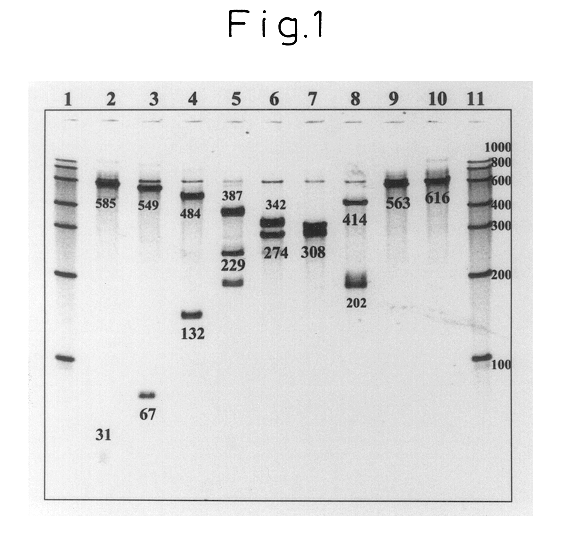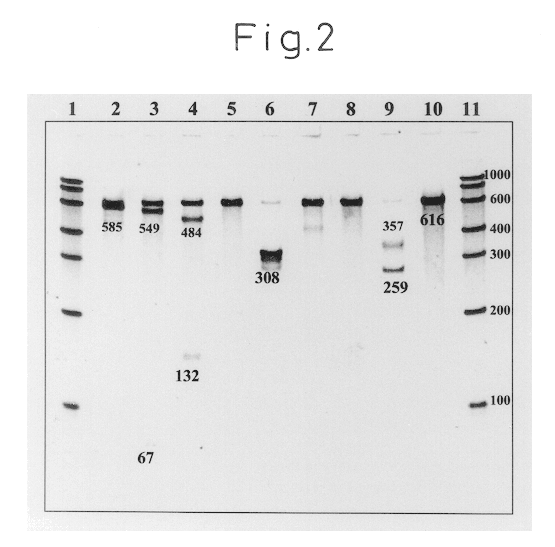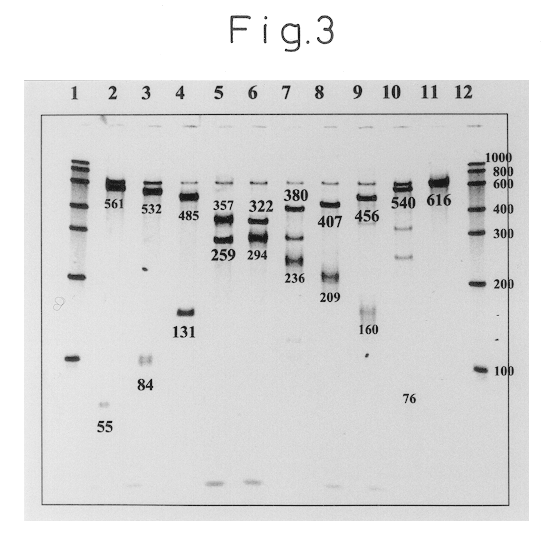Oligonucleotides for detection of Vibrio parahaemolyticus and detection method for Vibrio parahaemolyticus using the same oligonucleotides
a technology of oligonucleotides and oligonucleotide, which is applied in the field of oligonucleotides for detection of vibrio parahaemolyticus and detection method of vibrio parahaemolyticus using the same oligonucleotide, can solve the problems of complex and time-consuming, detection and identification of vibrio parahaemolyticus, and difficulty in obtaining sufficient detection sensitivity for food evaluation
- Summary
- Abstract
- Description
- Claims
- Application Information
AI Technical Summary
Benefits of technology
Problems solved by technology
Method used
Image
Examples
example 1
Specific binding of the oligonucleotides of the invention to trh1-RNA at 41.degree. C. was examined. The trh1-RNA is a synthesized and purified RNA obtained by in vitro transcription using double-stranded DNA containing the trh1 base sequence as the template.
First, a sample of a standard RNA (616 mer) comprising base Nos. 1 to 610 of Vibrio parahaemolyticus trh1-RNA (the RNA base sequence numbering is in accordance with Nishibuchi et al. "Appl. Environ. Microbiol., 1992, 58, pp.2449-2457") was quantified by ultraviolet absorption at 260 nm, and then diluted with a RNA diluent (10 mM Tris-HCl (pH 8.0), 0.1 mM EDTA, 0.5 U / .mu.l RNase Inhibitor) to 3.0.times.10.sup.-12 mol / .mu.l.
Next, 14.0 .mu.l of a reaction solution with the following composition was dispensed into a 0.5 ml volume PCR tube (GeneAmp Thin-Walled Reaction.RTM.; Perkin-Elmer Co., Ltd.).
Composition of Reaction Solution
20.0 mM Tris-HCl buffer (pH 7.5)
0.1 mM DTT
0.1 mM EDTA...
example 2
Specific binding of the oligonucleotides of the invention to trh2-RNA at 41.degree. C. was examined. The trh2-RNA is a synthesized and purified RNA obtained by in vitro transcription using double-stranded DNA containing the trh2 base sequence as the template.
First, a sample of a standard RNA (616 mer) comprising base Nos. 1 to 610 of Vibrio parahaemolyticus trh2-RNA (the RNA base sequence numbering is in accordance with Nishibuchi et al. "Appl. Environ. Microbiol., 1992, 58, pp.2449-2457") was quantified by ultraviolet absorption at 260 nm, and then diluted with a RNA diluent (10 mM Tris-HCl (pH 8.0), 0.1 mM EDTA, 0.5 U / .mu.l RNase Inhibitor) to 3.0.times.10.sup.-12 mol / .mu.l.
Next, 14.0 .mu.l of a reaction solution with the following composition was dispensed into a 0.5 ml volume PCR tube (GeneAmp Thin-Walled Reaction Tubes.RTM.; Perkin-Elmer Co., Ltd.).
Composition of Reaction Solution
20.0 mM Tris-HCl buffer (pH 7.5)
10.0 mM magnesium chloride
0.1 MM DTT
0.1 m...
example 3
Specific binding of the oligonucleotides of the invention to trh2-RNA at 41.degree. C. was examined.
First, a sample of a standard RNA (616 mer) comprising base Nos. 1 to 610 of trh2-RNA was quantified by ultraviolet absorption at 260 nm, and then diluted with a RNA diluent (10 mM Tris-HCl (pH 8.0), 0.1 mM EDTA, 0.5 U / .mu.l RNase Inhibitor) to 3.0.times.10.sup.-12 mol / .mu.l.
Next, 14.0 .mu.l of a reaction solution with the following composition was dispensed into a 0.5 ml volume PCR tube (GeneAmp Thin-Walled Reaction Tubes.RTM.; Perkin-Elmer Co., Ltd.).
Composition of Reaction Solution
20.0 mM Tris-HCl buffer (pH 7.5)
20.0 mM potassium chloride
10.0 mM magnesium chloride
0.1 mM DTT
0.1 mM EDTA
1.3 .mu.M of oligonucleotide primer solution
1.0.times.10.sup.-12 mol standard trh2-RNA sample
Distilled water for volume adjustment
As the oligonucleotide primer solutions, the oligonucleotide solution of SEQ. ID. No.6, the oligonucleotide solution of SEQ. ID. No.15, the oligonucleotide solution of SEQ. ...
PUM
| Property | Measurement | Unit |
|---|---|---|
| temperature | aaaaa | aaaaa |
| constant temperature | aaaaa | aaaaa |
| constant temperature | aaaaa | aaaaa |
Abstract
Description
Claims
Application Information
 Login to View More
Login to View More - R&D
- Intellectual Property
- Life Sciences
- Materials
- Tech Scout
- Unparalleled Data Quality
- Higher Quality Content
- 60% Fewer Hallucinations
Browse by: Latest US Patents, China's latest patents, Technical Efficacy Thesaurus, Application Domain, Technology Topic, Popular Technical Reports.
© 2025 PatSnap. All rights reserved.Legal|Privacy policy|Modern Slavery Act Transparency Statement|Sitemap|About US| Contact US: help@patsnap.com



